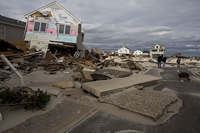The anniversary of Hurricane Sandy impacting the Atlantic seaboard is approaching in the coming days, but many small businesses and homeowners are still waiting to receive funding to repair their ravaged properties. Many business owners and residents were unprepared for the potential dangers of the system at the time and are still waiting to receive the money to fix what has been delayed for almost a year.
These efforts have taken a long time to mediate for organizations that cannot afford to delay operations. This is one of many reasons why a business continuity plan is valuable.
The Small Business Administration (SBA) approved a $2.4 billion loan to disburse to companies that reported losses, but payments have been slow and only about 24 percent of the total funding has been given to those affected, according to Businessweek. One reason for these delays has to do with SBA's need to obtain paperwork from borrowers.
Because a large part of the SBA's funding comes from "taxpayer funds," SBA's financial director John Miller explained that loans to each applicant will be capped at $200,000 per home owner with 2 percent interest rates and $2 million per business at a 4 percent rate.
Some families thought having house flood and home insurance would have streamlined operations to repair structural damage, but inaccurate adjustment reports have delayed many repairs. For example, John Lambert and Lee Ann Newland of Neptune, New Jersey had to pay $11,000 in out-of-pocket costs because the insurance agent failed to include sales tax in initial estimates, the Huffington Post reported.
Since Hurricane Sandy, some planned housing projects in New York City have been changed to protect tenants from future flooding or other weather-related dangers. Companies that wish to improve their business continuity strategy should reach out to business continuity consultants. The sooner action is taken, the faster operations can "go back to normal" after an event.

